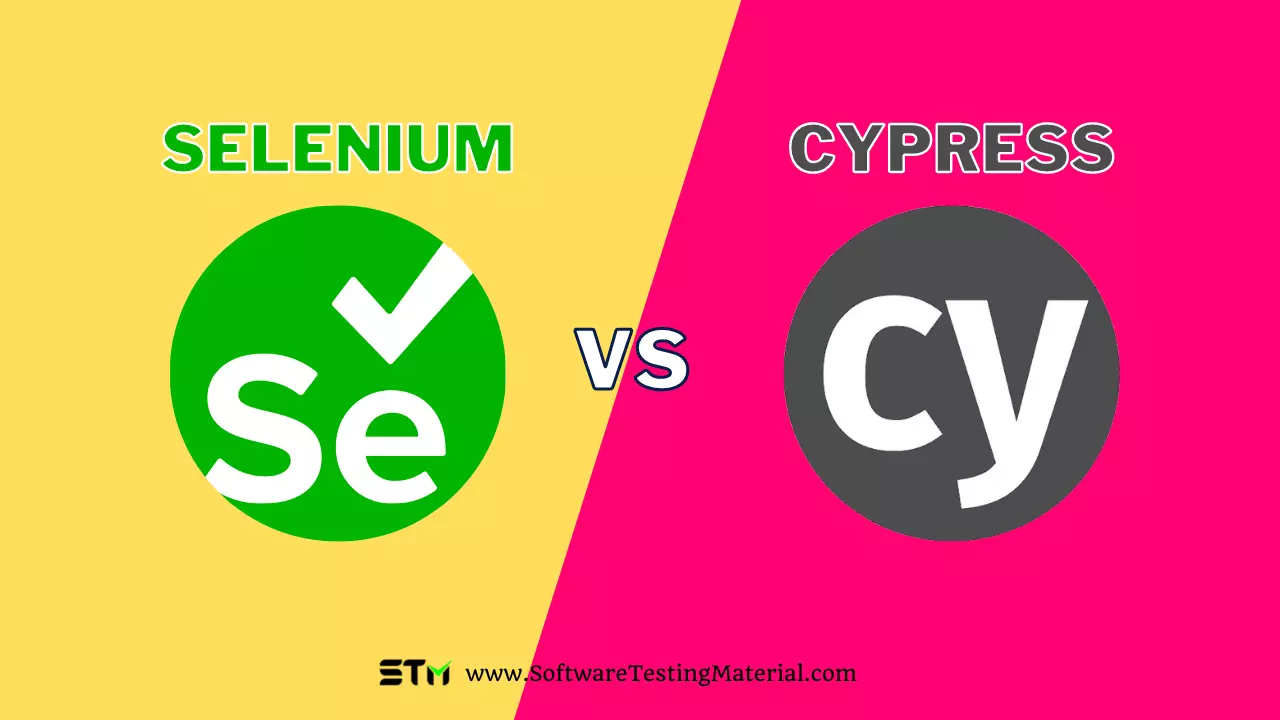Cypress vs Selenium – Which Is Better For Testing?

There is a lot of talk in the software testing community about Cypress vs Selenium.
As an automation enthusiast, comparing Cypress and Selenium is essential to understand their unique strengths and weaknesses. Both Cypress and Selenium are popular automation testing tools for automating web browser testing, but they cater to different needs and scenarios and also they have their pros and cons. By comparing them, testers can make more informed decisions about which tool best suits their project requirements.
In this post, we will compare Cypress vs Selenium and explore which tool is better for your needs. So you can decide which one is best for your needs. Let’s get started!
What Is Cypress
Cypress is a modern end-to-end testing framework used for end-to-end testing of web applications. It is designed to make the testing process fast, reliable, and easy to understand. With Cypress, you can write tests in JavaScript, making it accessible for developers who are already familiar with the language. One of the key features of Cypress is its ability to run tests directly in the browser, allowing you to see exactly what your users would experience. It comes with features like automatic waiting and retrying to ensure stable tests.
Additionally, Cypress comes with an easy-to-use dashboard that visually represents test results, making it easier for teams to collaborate and track testing progress. Numerous tools and plugins are available to extend Cypress’s capabilities, offering custom commands, integrations, debugging, and reporting features to optimize the testing process for web developers.
Cypress is generally compared with Selenium, but their architecture is different. Cypress does not have lot of restriction as selenium has. It makes Cypress to create your automation web scripts in a faster and easier way
Using Cypress anything can be tested which is running on a Browser, following testing can be automated by Cypress
Reasons to Use Cypress
- Cypress gives a fast and stable test execution as compare to other automation tools because of its Architectural design.
- Cypress has feature of screenshot capturing while test execution.it can also capture the video of test suite if it is running from the command line Interface.
- In Developer tools section, it gives debugging option which helps developers to debug fast and in easy way.
- Unlike other tools where wait and sleep are used to achieve synchronization in test runs, Cypress has inbuilt feature which waits by default until next actions and also waits before moving to next step.
- In Cypress we can see response time of an activity which is very useful for unit testing perspective.
- Cypress can be used with CI tools [Continues Integration tools-Jenkins].
- With the help of Viewport sizing feature, cypress can check responsiveness of a web page.
- Cypress provides test case status in a clear format, it displays count of test cases which are passed or failed.
- Cypress has good capability of error logging, which clearly describes the reason of any error or failure.
- Cypress has good documentation support, which helps developers and tester to write critical tests.
Advantages of Cypress
- Real-Time Feedback: Cypress gives you instant feedback while running tests. This helps you find and fix issues quickly.
- API Testing: Using Cypress, API testing can be done, which is not possible in other open source web automation tools.
- Dashboard for Results: It comes with a dashboard that shows test results, including screenshots and videos so you can see what’s happening in your tests.
- Easy Setup: Cypress is straightforward to set up and use. There is plenty of documentation and examples to get you started.
- Automatic Waiting: It automatically waits for things like network requests and web elements, making your tests more reliable. Like Selenium, there is no need to define explicit waits or sleeps in your tests.
- Time Travel: This feature lets you go back in time to see each step of a test. This makes it easier to figure out what went wrong and fix it.
- Highly Customizable: You can easily customize Cypress to work with other tools and frameworks, fitting your specific needs.
- Secure Testing: Cypress supports end-to-end encryption, keeping your data safe during testing.
- Code Coverage Reports: It automatically generates reports that show which parts of your code have been tested, helping you ensure thorough testing.
- Smart Debugging: Cypress streamlines bug detection by allowing you to pause tests and diagnose issues directly from the browser using familiar dev tools. Its human-friendly error messages and stack traces greatly simplify debugging.
- Extensive Documentation and Community: Cypress offers extensive documentation and a expanding community. A wealth of resources and community plugins enhance its functionality and allow seamless integration with other tools.
Disadvantages of Cypress
- Limited Browser Support: Cypress primarily supports Chrome-family browsers. This can be limiting if tests need to be run on other browsers like Safari or Internet Explorer.
- No Multi-Tab Support: Unlike some other testing frameworks, Cypress does not support multiple browser tabs or windows. Tests that require interacting with more than one tab can be challenging.
- Network Stubbing Issues: Cypress may face difficulties when trying to stub or intercept complex network requests, which can affect tests that rely heavily on network interactions.
- Heavy Dependency on JavaScript: Cypress is written in JavaScript, which means it might not be the best option if your project isn’t JavaScript-based.
- Limited Mobile Testing: Cypress lacks robust support for mobile device testing, so if your application needs thorough mobile testing, Cypress might not be adequate.
- Testing Limitations: Certain advanced testing features like file uploads and downloads are not as seamlessly handled by Cypress as they are by some other testing tools.
Must read: Cypress Interview Questions & Selenium Interview Questions
What Is Selenium
Selenium is open source testing framework, used for web application testing and supported by different platforms and browsers. Many programming Languages are supported by selenium like c#, java, python, ruby, Perl. Platform supported by selenium are Windows, Linux, Mac OS and Solaris.
Selenium 4 is the latest version of selenium. – Checkout Selenium 4 Tutorial here.
Selenium is made up of 4 following components
1. Selenium IDE [Integrated Development Environment]: To record and play the user actions and commands on the browser.
2. Selenium Web driver: To code the actions and commands to send to the browser.
3. Selenium Remote control: It’s a Server which helps interaction between selenium commands and browser.
4. Selenium Grid: Helps in distributed and parallel testing for example by using Selenium grid we can execute automation scripts on different physical or virtual machines simultaneously.
Don’t miss: Selenum 3 vs Selenium 4
Reasons to Use Selenium
- There are multiple reasons of using selenium the most significant reason of using this tool is it is an open source.
- It can be run on almost every browser and supported by maximum platforms.
- Using this tool we can write automation script in a language of our own choice
- We don’t need to be stick or dependent on a tool specific language.
Advantages of Selenium
- Open Source: Selenium is free to use, making it a cost-effective choice for businesses of all sizes.
- Multiple Language Support: Developers can write test scripts in various programming languages, such as C#, Java, Python, Perl, Ruby etc.
- Multiple Platforms: Selenium supports multiple platforms like Windows, Linux, iOS
- Cross-Browser Testing: Ensures that web applications work effectively across different browsers like Chrome, Firefox, and Safari.
- Community Support: A large and active user community means plenty of resources, tutorials, and forums are available.
- Extensible: Selenium is highly customizable, and you can add plugins and tools to enhance its functionality.
- Parallel Test Execution: Allows running multiple tests at the same time, speeding up the testing process.
- Integration with CI/CD Tools: Easily integrates with Continuous Integration/Continuous Deployment tools like Jenkins, enabling automated testing in the software development lifecycle.
- Mobile Testing Support: Selenium with Appium helps in Mobile testing, which is very rare with other open testing tools.
Limitations of Selenium
- Steep Learning Curve: Beginners may find Selenium challenging to learn without proper training or experience in programming.
- Maintenance Effort: Test scripts need regular updates to accommodate changes in the web application, which can be time-consuming.
- Limited Mobile Testing: Selenium is primarily designed for web applications and has limited capabilities for mobile app testing without additional tools.
- No Built-in Reporting: Selenium lacks built-in reporting features, necessitating the use of third-party tools to generate test reports.
- Browser Compatibility Issues: Occasionally, Selenium may face compatibility issues with certain versions of browsers or browser updates.
- Pop-up Window Handling: Managing pop-up windows can be cumbersome and complex, requiring additional efforts from testers.
- Application support: It works only on web based application. Windows automation can’t done by Selenium.
- Captcha & Barcode: Selenium won’t support automating Captcha and Barcodes.
- Image & video capturing support: Capturing of Screen is supported by selenium but still testing of Images, video and audio cannot be done by Selenium
Detailed Post: Challenges and Limitations of Selenium
Compare Cypress and Selenium
Selenium and Cypress both are open source web test automation frame work, but both have some difference. Following are the key difference between the two.
| Category | Cypress | Selenium |
|---|---|---|
| Architecture | Unlike other testing tool which works out side of the browser, Cypress is present inside the browser. With the help of Node.js server it interacts with both the front and back end of the applications. It’s very easy for Cypress to access Window objects, local storage, browser developer tools, Document object model which makes this tool very vast and easy for automation. It supports end-to-end testing framework. | Selenium has Webdriver API which interacts between Browser and Browser drivers. Selenium is consists of 4 layers JSON [JavaScript Object Notation] wire protocol, Browser Drivers, Browsers and Selenium client library. For every Browser different driver is needed. It supports web testing framework. |
| Target Audience | Cypress can be used by Developers and tester both. | Selenium is only used by Testing team. |
| Browser supported | Chrome, Firefox, Edge, Brave, and Electron browsers. | Google Chrome 12+, Firefox 3+ Internet Explorer 7,8,9,10, Safari 5.1+ Opera 11.5. |
| Open Source | Open Source / some features are paid. | Open source. |
| Operating systems | Windows 7 and above, MacOS, Linux, Fedora, Debian. | Windows, Mac, Linux/Unix). |
| Language supported | Java Script only. | JavaScript (Node. js), Python, Ruby, Perl, PHP, Java, Kotlin, and C#. |
| Frameworks supported | Mocha JS only. | Multiple frameworks based on specific programming languages. (JUnit for Java, Cucumber for JavaScript, etc.). |
| Ease of Setup | Low as no dependency on any driver and all required files comes in a bundle. | Medium- because selenium web driver and browser drivers needs to install separately. |
| Dependencies | No dependency on any driver. | Dependent on Drivers like different browsers. |
| Test runner | Includes built-in test runner. | Requires a separate test runner (JUnit, TestNG). |
| Debugging | Intuitive interface for seamless debugging. | Debugging is more complex and requires additional tools. |
| Test stability | Stable and reliable tests due to automatic wait and retrying. | Less stable due to timing issues or race conditions. |
| Speed | This architecture doesn't utilise WebDriver so its faster compared to Selenium. | Selenium itself is fast but due to network communication overheads, it is slower than Cypress. |
| Parallel Testing | Yes | Yes - using Selenium Grid. |
| Mobile Testing Support | No | Yes – using Appium. |
| DOM manipulation | Uses its own built-in DOM manipulation functions. | Depends on JavaScript for DOM manipulation. |
| Integration & plugins | Limited integration but rich set of plugins. | Integrates well with CI, CD, visual testing, reporting tools, and cloud vendors. |
| Documentation | Extremely intuitive documentation. | Well-established documentation. |
| Community Support | Expanding community. | Robust global community support from users worldwide. |
| Audience | Developers & Testers. | Testers & Automation engineers. |
| License | Core features are free, but some advanced features need a subscription. | Free |
Don’t miss: Katalon vs Selenium
Target Audience for Cypress & Selenium
When To Choose Cypress
Cypress is a relatively newcomer in the testing domain but has rapidly gained popularity due to its simplicity and modern architecture. It is particularly attractive to front-end developers and testers who are working with modern JavaScript frameworks like React, Vue, and Angular.
- Front-End Developers: Cypress is highly integrated with JavaScript, making it easy for front-end developers to write tests.
- QA Engineers: Its straightforward setup and user-friendly interface are ideal for QA engineers who need efficient and effective testing solutions.
- Small to Medium-Sized Projects: The simplicity and ease of use make it suitable for small to medium-sized projects where quick iteration and testing are essential.
- Agile Teams: Agile teams benefit from Cypress’s rapid setup and execution, allowing for faster development cycles.
When To Choose Selenium
Selenium has been around for a long time and has built a solid reputation as a reliable testing framework. It is more versatile, supporting a broader range of applications and environments.
- Experienced Developers and Testers: Due to its complexity and rich feature set, Selenium is best suited for experienced developers and testers who are comfortable with scripting and detailed configurations.
- Large Enterprise Applications: Selenium’s flexibility and extensive support make it ideal for testing large-scale, enterprise-level applications that require rigorous, comprehensive testing.
- Cross-Platform Testing: Its compatibility with multiple operating systems and browsers makes it a go-to choice for projects needing extensive cross-platform testing.
- QA Teams in Need of Advanced Capabilities: For teams that require advanced testing capabilities, such as complex automation and integration with other tools, Selenium provides the needed flexibility and power.
Choosing between Cypress and Selenium largely depends on your team’s needs, experience level, and the specific requirements of your project.
Cypress vs Selenium – Confirming the Best Automation Testing Tool
It’s time to decide which tool is the best out of Selenium and Cypress.
Selenium, a long-established automation testing tool, is widely used but complex and supports multiple browsers and programming languages. Cypress, a newer tool, is gaining popularity due to its ease of setup, faster execution times, and simpler architecture, though it only supports JavaScript, making it a great choice for modern web applications with complex JavaScript heavy interactions.
While Cypress excels in ease of use and faster execution, it can’t fully replace Selenium, especially for large projects. Both tools require significant coding and maintenance. Also, If your team is already using Selenium, switching to Cypress isn’t advisable unless you’re considering a significant upgrade.
FAQs: Selenium Vs Cypress
Who are the target audience for Cypress and Selenium
Target audience are based on the objective of the test automation, if the objective is to automate Unit, Integration and End to end testing then Cypress is the only choice, and both Developers are QA are the audience for Cypress.
But on the other hand if the objective is just to test the application UI and Functionality on the web browser then Selenium is the best choice.
Only drawback of using a Cypress is it is purely based on JavaScript which may be difficult for testing people because in general testing people know programming language but not a Scripting language.
Will Cypress replace Selenium
It is difficult to say if Cypress will replace Selenium or not, because selenium is a very old tool and very popular among the testing folks and continuously improving its feature.
Cypress is more popular among those Developers who want to automate their Unit testing or Integration testing tasks.
Cypress is a great tool for API testing, which is not possible in Selenium.
When it comes for cross browser testing, Selenium is the best choice because it supports more browsers compared to Cypress.
If we talk about the accuracy and speed of test automation then Cypress comes first because it is present inside the browser, Synchronization issue is very rare in Cypress, unlike the Selenium, where Scripts are running out side of the browser.
Can I use Cypress with Selenium?
No, you cannot use Cypress with Selenium directly, as they are two different tools designed to handle automated testing independently. While Selenium can be used with various programming languages and frameworks for broad test automation, Cypress is focused on JavaScript and offers an all-in-one solution. They serve similar purposes but are not designed to be used together. If you want to with from Selenium to Cypress, it is advisable to make a complete switch.
Which is easier Selenium or Cypress?
For many people, Cypress is easier to use compared to Selenium. This is because Cypress has a more straightforward setup and provides a complete package for testing. It also offers better documentation and more user-friendly error messages, making it simpler for beginners to get started. Selenium, on the other hand, is more flexible but can be more complex to configure and requires more knowledge of different programming languages and testing frameworks.
Is Cypress the future of automation?
Cypress is gaining popularity in the field of automation because it is easy to use and has strong support for modern JavaScript frameworks. Its user-friendly setup and clear error messages make it great for beginners and seasoned developers alike. However, whether Cypress will be the future of automation depends on your specific needs and the growth of the tool over time. It is a strong contender but not the only option available.
Which is better, Cypress or Selenium?
The choice between Cypress and Selenium depends on your needs. Cypress is easier to set up and use, with better error messages and support for modern JavaScript frameworks, making it ideal for new testers. Selenium, however, is more flexible and supports a wide range of programming languages and browsers, which can be beneficial for complex, large-scale projects. So, if you value simplicity and ease of use, go for Cypress. If you need more flexibility and versatility, Selenium might be the better option.
Is Cypress in demand?
Yes, Cypress is in demand. Many companies like using Cypress because it is easy to set up and works well with modern web applications. Its simplicity and user-friendly design make it popular among developers and testers. As more businesses build complex web applications, the demand for Cypress continues to grow.
Which is better, Playwright or Cypress or Selenium?
Choosing between Playwright, Cypress, and Selenium depends on what you need. Cypress is easy to use and great for testing modern websites but is limited to JavaScript. Selenium is very flexible, supports many languages, and works with a lot of browsers, but can be harder to set up. Playwright offers a mix of both, supporting multiple languages and modern web testing. If you want simple and easy, go with Cypress. For flexibility, choose Selenium. For a balance of both, Playwright is a good option.
Related posts:
- Selenium vs Katalon – Which one is better?
- Selenium vs Playwright – Which one is better?
- Selenium vs Puppeteer – Which one is better?
- Best Playwright Alternatives
- Selenium Tutorial
- Katalon Tutorial






